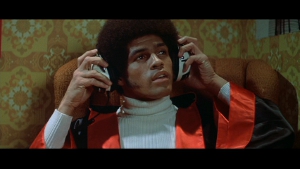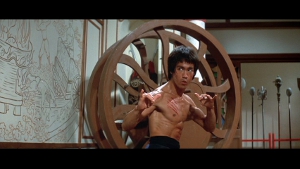
Even though this was the last (complete) film Bruce Lee made before his untimely death, it became an introduction to the man’s work for a lot of North Americans, including yours truly.
Which is too bad, really, because Enter the Dragon‘s far from Lee’s strongest work. As a kid, of course, its vibrant, comic strip-inspired color scheme and its Bruce Lee-choreographed fight scenes kept me happy. But now that the film’s pushing forty I can’t help but see the cracks in its foundation. Just goes to show you can never tell what will ultimately become influential, and you don’t have to be a perfect movie to be well-regarded, well-remembered, or perpetually ripped-off. (Hell, look at 2001…Or save yourself two hours and don’t! Ha! Zing!)
You also don’t need me to tell you how influential this film’s been: pick a martial arts movie from the last forty years. Odds are you’ll see St. Bruce’s hand prints somewhere, and in more than a few cases filmmakers intentionally invoke his spirit, hoping to make their film a even a tenth as cool as…ohsayforexample, this one. Allow me to dash those hopes right now, filmmakers of the future, because until the day you really can make Bruce fight back…from the grave… it ain’t gonna happen.
This is the point where a nostalgic critic asks you to “try and imagine what it was like sitting in a typical theater in 1973, watching this, when you’d probably never seen a damn thing like it unless you were lucky enough to live in New York or LA or San Fran.” But to hell with that. Despite being one of the most ripped-off films of all time (it directly inspired the Mortal Kombat franchise, to pick the obvious example), the lack of Bruce Lee means you will still never see a film like Enter the Dragon. And that’s sad on so many levels I’d need a quantum computer to calculate them all. Through life, Lee chased “real” success as a big time, Hollywood star, never achieving it until he became a star in Hong Kong, where being Chinese was no hindrance to landing a lead role.
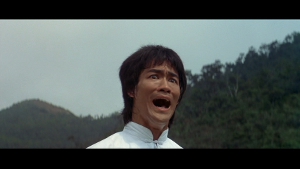
So after Way of the Dragon became…well, Way of the Dragon…a BFF from Lee’s Green Hornet days, producer and Warner Brothers exec Fred Weintraub, created this specifically to function as Lee first major Hollywood studio picture. Filmed in Hong Kong by a Wisconsinite, Enter the Dragon‘s an intentionally international movie, made to introduce a rising star to a wider world only Warner Brothers could reach. No surprise a stunning plot was the last thing on their minds and they banged the script out in under three weeks, with Bruce supplying all of the material he’s best remembered for anyway (Including, “What was that? An exhibition? You need emotional content!”). Why not let him write the script, act it out and choreograph all the fights? That’s what he did on Way of the Dragon, and he knew what ground he’d already stamped flat better than anyone. Might’ve provided us with a slightly more engaging excuse to showcase his talents.
Instead, producer Paul Heller pawned the duty off on a hungry young writer friend, so the plot is deceptively simple: Bruce Lee plays…umm…Bruce Lee…a Shaolin monk tasked with bringing one of his monastery’s former students, Han (Kien Shih), to justice. Han’s perverted the teachings of his monastic order and set himself up as a private island-owning supervillain, complete with his own martial arts tournament. To which, it just so happens, he’s invited Bruce. How convenient.
Braithwaite (Geoffrey Weeks), an agent of British Intelligence, echos the “go deal with Han for us, pretty please” request and sets up the exposition for Bruce (and us). No guns are allowed on Han’s Island, but beautiful women and international martial artists have a bad habit of never returning from it. Intelligence has an agent inside (Betty Chung), but no worthwhile evidence. Ordinary people obviously aren’t cutting this cheese – the world needs Bruce Lee. And since he’s Bruce Lee, he’s more than willing to help them. Like any good superhero, this Bruce has a Personal Stake in the action and a Defining Element of Tragedy driving him to Do What’s Right.

First thing you notice: this narrative could’ve been transplanted from any given Bruce Lee movie. Instead of killing Lee’s master, Han’s main thug, O’Hara (Robert Wall) killed Lee’s sister, Su Lin (Angela Mao), but that’s a pretty superficial difference in the grand scheme of things. Less so’s the way the narrative changes tracks here, suddenly becoming about inveterate American gambler named Roper (John Saxon).
Just as suddenly, I remember why I can never remember a two thirds of this movie: they have nothing to do with Bruce Lee. One thread follows Roper’s budding friendship with Lee, his relationship with resident “Dragon Lady” Tania (Ahna Capri), and Han’s attempts to recruit Roper into the drugs-and-drugged-up-hookers racket Han runs out of the basement. The other thread concern’s Williams (Jim Kelly), an LA Karate man on the run from the racist cops (In 1970s LA? Say it ain’t so.) who eventually winds up on the wrong side of Han’s prosthetic hand. Can you tell they started out calling this movie The Big Three?
Don’t get me wrong: I appreciate this rainbow coalition of asskickers. Jim Kelly is the man, and it’s no surprise everyone involved immediately teamed up to give him his own film. John Saxon’s enough of an actor to keep his own fatigue from showing, to say nothing of being a surprisingly effective stage fighter, developing an interesting hybrid style under Bruce’s tutelage (looks like a mix of Wing Chung and ol’ fashioned boxing to these eyes). But the two of them are rendered ultimately superfluous thanks to Bruce’s presence. Perhaps you could say Williams’ death provides Roper with a Moment of Clarity and/or Tragedy (spoiler alert: the black guy dies) but…so what? By the end of the film, even Roper’s jettisoned so we can focus on the Lee vs. Han fight.

It’s evident (at least to me) that this was a lot of people’s first chopsocky movie, from the producers (except for Raymond Chow, obviously) to screenwriter Michael Allin, to director Robert Clouse, primarily known up to this point for his dramas and one episode of Ironside. I can understand why they went for the safe bet and cast a couple of Americans to stand beside Lee and soften the blow for any racists in the audience who might’ve balked at the presence of an actual “Chinaman” in a Warner Brothers movie. Jim Kelly gets most of the film’s best lines, and John Saxon provides Lee with a necessary, non-Odious Comic Relief sounding board. I’m not saddened by their presence here…but I can’t shake the feeling Lee could’ve played all of them, simultaneously. As evidence, I submit any other film from his filmography. Go ahead: pick one at random.
This means I’m the type of asshole who, at this point in his life, would rather watch any other Bruce Lee film. And now I’m struggling to find something to say about this one when it’s importance assures it’s another one of those dreadfully over-reviewed films.
Alright, here’s something: Enter the Dragon contains its own historical commentary. It’s all there the scene where Lee’s recruited by British Intelligence. Negative reviewers during its original release used this as an excuse to mistake Enter the Dragon for yet another low rent James Bond knockoff…but there’s more going on here than meets the snotty movie reviewer’s eye.
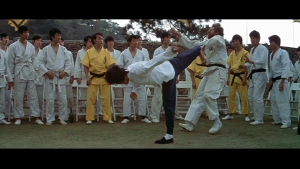
Enter hit screens in August, 1973, less than two months after Live and Let Die began the Roger Moore Era. This followed years of widespread speculation that Sean Connery was…shall we say, “getting on a bit” for his role? Yes. So we shouldn’t be surprised Braithwaite, the Queen’s man in Hong Kong, is a dottering, white haired old drunkard with nothing on Han and only the vaguest jurisdictional excuse to investigate him in the first place. The movie Action Hero of the 60s is visibly passing away, his archetype aging before the audience’s very eyes. He’s come to the Shaolin temple to recruit a new, far sprightlier generation of warriors for peace and justice – someone to share the spotlight with their gun-totting, Dirty Harry-aping, American cousins. Both strains of 70s Action Hero eventually inspired the generation after them to beat The Matrix with a synchronization of both the armed and unarmed fighting styles they perfect here. All of which works on a metaphorical, metafictional level that tickles my nerd brain like you wouldn’t believe.
God knows I have to think of something while Lee sneaks around, gathering intel he doesn’t really need on Han’s operation. Dude: the guy’s thugs killed your sister. And they aren’t shy about killing other competitors (or each other) in front of hundreds of witnesses. At this private martial arts tournament. No one staging a private martial arts tournament is ever up to any good! At best, he’s a criminal mastermind using the whole thing as an excuse to not hire a Human Resources Department. At worst…you’re looking at a Most Dangerous Game scenario.
Jim Kelly says it best when he disses Han, “Man, you are right out of a comic book.” With his Island Fortress and his metal hand and his white cat that he strokes as he monologues to John Saxon about how “strength makes all other values possible. Nothing survives without it!” His white cat that he almost guillotines in front of John Saxon’s eyes (before John saves the poor kitty’s life and delivers his best line: “Now, you’ve got eight more”). He’s the evilest kind of eee-vil villain, saved only by the fact he’s played by a great Hong Kong villain actor. How great is Shih Kein? At the height of his popularity, Shih Kein’s Villainous Laugh was as parodied over there as Dr. Evil’s was over here during the late-90s, when we still had a sense of humor.
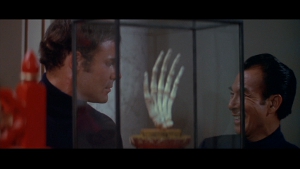
These days, we’re ruled by humorless dickheads, so I feel compelled to spell out the fact that, even after all my complaining, I still love the last thirty-six minutes of this film. If you can get through the first hour and five, you’ll be fine…but that hour has a real problem of focus. When you get right down to it, this is an isolated James Bond story, with Bond’s personality divided across three characters. Roper is the gambling addict with the Heart of Gold, Williams the Ultimate Ladies Man who Don’t Give a Fuck, and Bruce Lee…is Bruce Lee, Ultra-Spy. Together, they would form the Fantasy Mission Force…if they ever actually got together. One dies and the other gets kinda lost in this movie’s glorious clusterfuck of a climactic action sequence. We’ve got to follow Bruce into Han’s Hall of Mirrors. (No evil mansion’s complete without one.)
Like any good actor, Bruce does what he can with what he has, but here he’s given the least fun character out of our three leads and gets the least screen time…until the very end. As a western audience member, I’m supposed to get Williams instinctively: he’s a smooth brother on the run. Same with Roper: he’s a dude who wouldn’t pass up a long shot to pull kitties out of guillotines…or would he? See? There’s a question there, and questions can create conflict. Conflict can create drama. We know exactly what Bruce is going to do throughout all this, but what the hell’s John Saxon going to do? Move to Ohio, become a small town sheriff, get married, settle down and have a daughter who’ll grow up to be Heather Langenkamp?
Of course, we all know Bruce and Saxon are going to play hero in the end, but that’s not the point. Your plot can be a tottering tower of cliched bullshit so long as that tower’s well-constructed. Enter the Dragon‘s first half is cursed by shoddy pacing and a tendency to let the (well-constructed) sets do all the heavy lifting. It’s back end’s is full of great fights and some of the most iconic images in martial arts cinema, I just wish the front end lived up to it.

I’m not going to climb a rooftop and shout, “Enter the Dragon was tainted by the Hollywood system” – it wasn’t – but I am going to say it was compromised and the quality suffered, especially in comparison to Lee’s previous films. The man’s still in his prime here, the sheer gravitation pull of his own awesomeness commanding the camera follow him, no matter how stiff Clouse’s direction might become at times. When Lee gives some poor soul that flat-eyed, don’t-fuck-with-me stare – unleashing the full force of his deadlights – you believe he’s a human timebob. But when he’s lecturing a student on the proper state of mind, an easy going, laid back human being peaks through all the muscle and duck calls. If I were a moviegoer in 1973, I might ask, Who is this person? I’d like to see him in more movies. I’m going to go out and watch all of his movies right now.
Good thing I live in a year that starts with a the number 2, already own all of Lee’s movies, and can say with a clear conscience, for all its structural faults, at least Enter the Dragon‘s better than Game of Death. See it, own it, love it, share it. Be like water, my friends.
![]()
![]()
![]()
